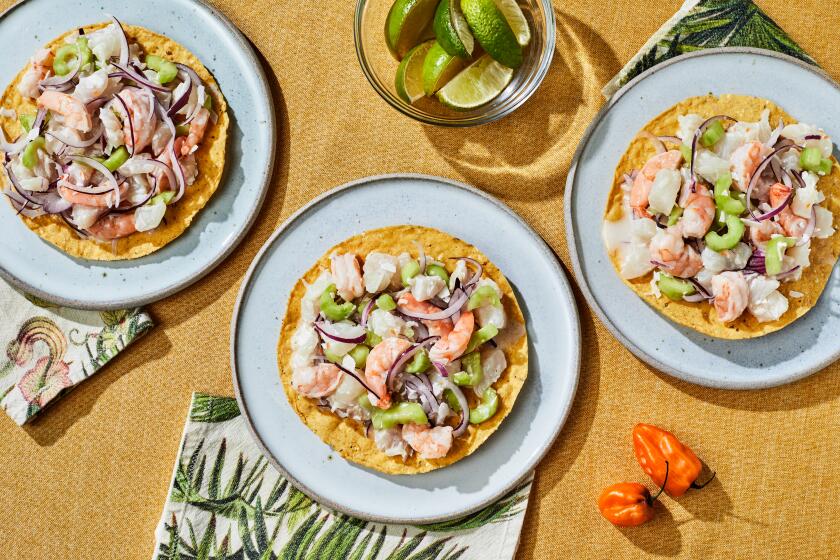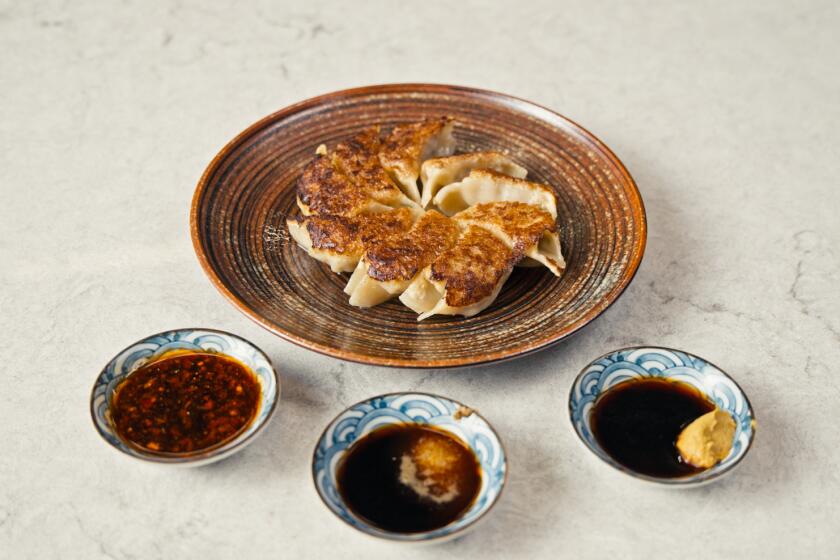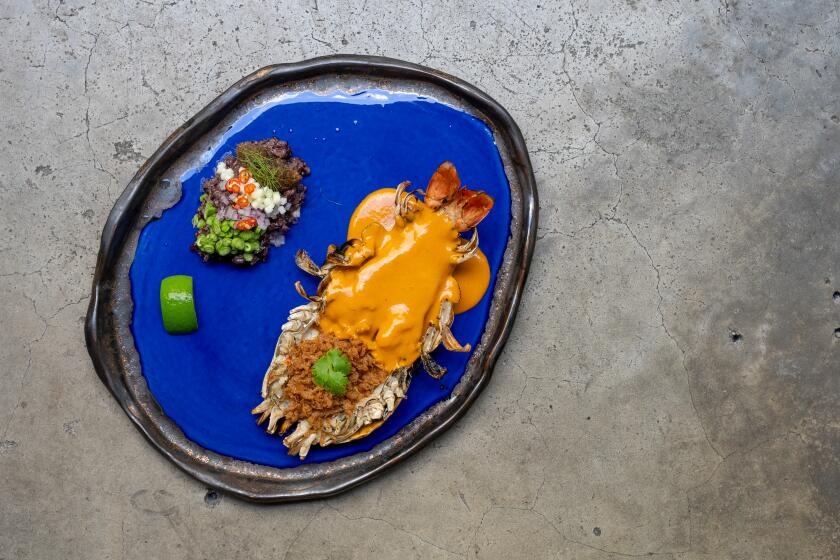Poached eggs in white wine gelee
A cool shimmer of gelee catches the light, and suspended beneath its glassy sheen like a summer mosaic is a perfectly poached egg, an asparagus tip, some fresh peas, slices of carrots, pieces of tender green beans and sprigs of herbs. Spoon into it, first breaking into the smooth gelee and then into the rich, velvety egg.
One bite, and the flavor of the gelee shines through, bright and refreshing and citrusy -- because it’s made with Sauvignon Blanc. It’s the white wine gelee that makes this classic French dish appealingly modern. Traditionally, oeuf en gelee is set in aspic jelly made with a clarified veal stock. But using white wine gelee in lieu of a veal aspic turns it into something altogether new.
White wine gelee is perfect in summer -- it’s cool and smooth and delicate. Pair cubes of it with fresh berries in a stemmed glass or layer it with panna cotta. Use it to garnish poached chicken or salmon. Put a thin layer of it over canapes.
A gelee is simply liquid set with gelatin. Traditionally, the liquid for a savory gelee is fish or meat stock that’s been reduced to concentrate the flavor and clarified because it “must always be crystal clear and a light, golden color,” according to “The Art of Garde Manger,” published by the Culinary Institute of America in the 1970s. Add white wine to the mix and the flavor is brightened, sharpened, more focused.
It’s sort of an elaborate process, but the result isn’t fussy -- it’s coolly beautiful, a literally sparkling layer or base for more dishes than you’d think.
A terrine of chicken liver pate, spiced with a touch of nutmeg, begs for a layer of gelee, which gets a sort of honeyed voluptuousness from the addition of Monbazillac, a sweet wine from southwest France. Start with chicken stock, preferably homemade; it’s worth it for the depth of flavor, but you can use commercial chicken broth as a substitute. To clarify the stock or broth, simmer it with a couple of egg whites and egg shells. The egg whites coagulate to form a “raft” and draw impurities from the liquid. Discard the raft and what remains is clear stock. Add softened gelatin to the stock, along with the Monbazillac. Decorate the top of the pate with chives, then gently spoon the gelee, set just to a syrupy stage, over it. Finally, chill the pate until it’s completely set.
Eggs in gelee are common in French charcuteries. Rows of them are lined up in refrigerated cases, decorated with sunbursts of tarragon leaves or sprigs of dill or wrapped with slices of ham or smoked salmon. Served with toasted brioche, they’re perfect for brunch.
Once you make the vegetable stock (which you don’t need to clarify) and add the gelatin, chill it, stirring gently, in a bowl over ice water so you can see when it begins to thicken (it will happen quickly). Then stir in the blanched vegetables -- they should be suspended in the gelee -- and assemble.
Or for dessert, make a gelee from the juices of crushed poached grapes and white Port. Once cooled and set, cut it into cubes and scatter them atop fresh figs poached in white Port with a little vanilla and lime peel. It all comes together with a drizzling of the figs’ poaching syrup.
What could be cooler?
Fill a large saute pan with water and bring to a boil. Adjust the heat to keep the water at a steady simmer. Break each egg into a small saucer or ramekin and slip the eggs into the water one at a time. Simmer until the whites of the eggs are done but the yolks are still runny, about 3 minutes. Lift each egg out of the water with a slotted spatula into a shallow glass dish filled with cold water. Refrigerate the eggs in the water until you’re ready to assemble.
Bring a small saucepan of water to a boil over high heat, then adjust the heat to maintain a steady simmer. Add the peas and salt and cook about 2 minutes until tender yet crisp. Use a slotted spoon to remove the peas from the saucepan to a bowl of ice water fitted with a strainer. Once the peas are chilled, lift them out of the ice water in the strainer and gently pat dry on paper towels. Repeat the same process with the carrot slices, cooking them for 1 1/2 minutes. Then the haricots verts, cooking them 2 minutes. Cook the asparagus tips about 2 minutes, until tender. Refrigerate the vegetables until you are ready to assemble the gelee.
To make the stock, add the leeks, carrots and celery to a large heavy-bottomed saucepan with 2 tablespoons water. Sweat the vegetables over medium low heat in the water until slightly softened, about 10 minutes, stirring occasionally.
Stir in 4 cups water, the peppercorns, bay leaf, parsley, fennel and thyme. Bring to a boil over high heat, then reduce the heat and simmer 30 minutes. Skim off foam, if necessary.
Remove the stock from the heat and strain through a cheesecloth-lined, fine-mesh strainer. Gently press the vegetables to extract the liquid. Discard the vegetables. You should have about 2 cups stock. Place the stock back in the pan over high heat and reduce to 1 1/3 cups.
Place the wine in a small bowl and gently sprinkle the gelatin over, allowing it to moisten in the wine. Stir the wine-soaked gelatin into the reduced stock until it is dissolved, then stir in the lemon juice and salt. Chill the gelatin in a metal bowl over another bowl of ice water until it just begins to thicken but is not yet set. Immediately remove the gelatin from the ice bath.
Stir the blanched peas, carrots and haricots verts into the thickening gelatin; they should be suspended in it. Spoon about one-fourth cup of the gelatin mixture into the bottom of each of four lightly oiled 6-ounce ramekins. Press 3 or 4 chervil leaves into the gelatin of each ramekin. Then put a well-drained poached egg on top. Cover each egg with the remaining gelatin-vegetable mixture.
Press a blanched asparagus tip onto the top of each ramekin so the asparagus is covered in gelee. Press a few chervil leaves into the gelatin over the top of each ramekin.
Put the ramekins on a tray and chill until set, at least 2 hours or overnight. To unmold, run a knife around the edge of each ramekin. Put the bottom of each ramekin under warm water and shake to release from the dish. Turn upside down onto a plate or platter to serve.
Get our Cooking newsletter.
Your roundup of inspiring recipes and kitchen tricks.
You may occasionally receive promotional content from the Los Angeles Times.
















